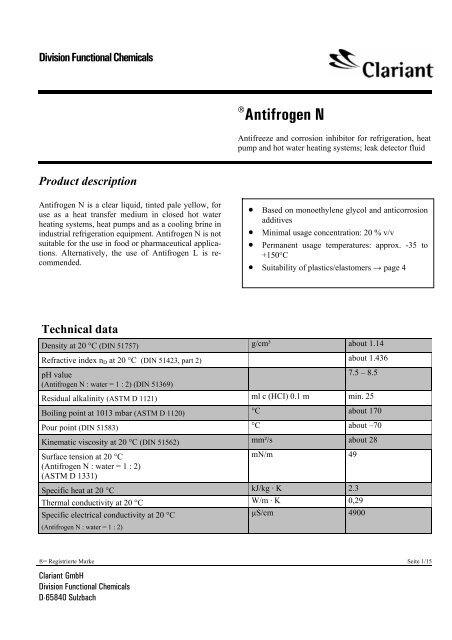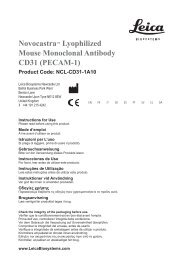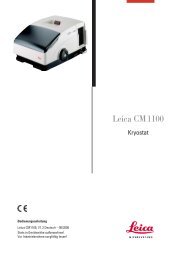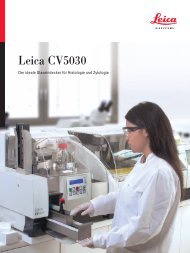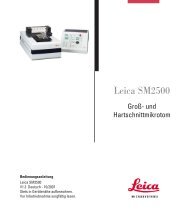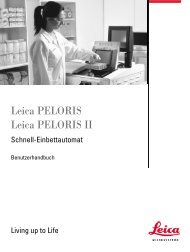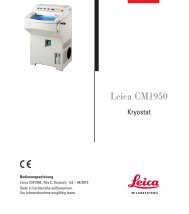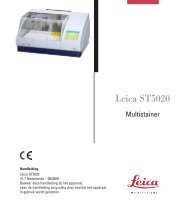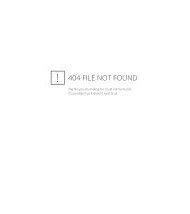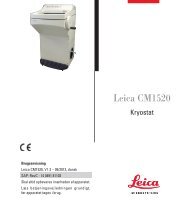Vorlage für Produktmerkblätter Clariant GmbH ... - Leica Biosystems
Vorlage für Produktmerkblätter Clariant GmbH ... - Leica Biosystems
Vorlage für Produktmerkblätter Clariant GmbH ... - Leica Biosystems
You also want an ePaper? Increase the reach of your titles
YUMPU automatically turns print PDFs into web optimized ePapers that Google loves.
Division Functional Chemicals<br />
Product description<br />
Antifrogen N is a clear liquid, tinted pale yellow, for<br />
use as a heat transfer medium in closed hot water<br />
heating systems, heat pumps and as a cooling brine in<br />
industrial refrigeration equipment. Antifrogen N is not<br />
suitable for the use in food or pharmaceutical applications.<br />
Alternatively, the use of Antifrogen L is recommended.<br />
Technical data<br />
®= Registrierte Marke Seite 1/15<br />
<strong>Clariant</strong> <strong>GmbH</strong><br />
Division Functional Chemicals<br />
D-65840 Sulzbach<br />
® Antifrogen N<br />
Antifreeze and corrosion inhibitor for refrigeration, heat<br />
pump and hot water heating systems; leak detector fluid<br />
• Based on monoethylene glycol and anticorrosion<br />
additives<br />
• Minimal usage concentration: 20 % v/v<br />
• Permanent usage temperatures: approx. -35 to<br />
+150°C<br />
• Suitability of plastics/elastomers → page 4<br />
Density at 20 °C (DIN 51757) g/cm³ about 1.14<br />
Refractive index nD at 20 °C (DIN 51423, part 2) about 1.436<br />
pH value<br />
(Antifrogen N : water = 1 : 2) (DIN 51369)<br />
7.5 – 8.5<br />
Residual alkalinity (ASTM D 1121) ml c (HCI) 0.1 m min. 25<br />
Boiling point at 1013 mbar (ASTM D 1120) °C about 170<br />
Pour point (DIN 51583) °C about –70<br />
Kinematic viscosity at 20 °C (DIN 51562) mm²/s about 28<br />
Surface tension at 20 °C<br />
(Antifrogen N : water = 1 : 2)<br />
(ASTM D 1331)<br />
mN/m 49<br />
Specific heat at 20 °C kJ/kg · K 2.3<br />
Thermal conductivity at 20 °C W/m · K 0,29<br />
Specific electrical conductivity at 20 °C<br />
µS/cm 4900<br />
(Antifrogen N : water = 1 : 2)
Division Functional Chemicals<br />
Notes on use<br />
Product properties<br />
The technical data below is used to describe the product<br />
and is taken from our own measurements or from<br />
literature. It does not constitute part of the delivery<br />
specification. The mandatory product specification will<br />
be found in the current technical data sheet.<br />
The certified quality system in accordance with DIN<br />
EN ISO 9001 is used in production and quality control.<br />
This ensures consistently high product quality.<br />
Application properties<br />
Antifrogen N was develped for use as a heat transfer<br />
and refrigerating medium. Its antifreeze action is based<br />
on monoethylene glycol, which with its high boiling<br />
point of about 198 °C prevents loss by evaporation.<br />
The frost resistance is determined by the mixing ratio<br />
with water. The frost resistance curve in the appendix<br />
shows that below a frost resistance of -20 °C solidified<br />
Antifrogen N/water mixtures will not cause bursts under<br />
central European conditions because slush ice is<br />
formed when they are cooled below the crystallization<br />
point. Phase separation of Antifrogen N/water mixtures<br />
does not occur.<br />
The frost resistance of the mixture does not change<br />
even after many years’ use, provided the Antifrogen N<br />
concentration remains constant.<br />
The critical heat transfer coefficients of the Antifrogen<br />
N/water mixtures commonly used are only slightly<br />
different from the coefficient of tap water alone when<br />
heat is transferred to the atmosphere via radiators. In<br />
such cases, the quantity of heat that can be transferred<br />
with an Antifrogen N/water mixture is practically the<br />
same as for water alone and so the heat exchange surfaces<br />
do not need to be modified. In liquid/liquid heat<br />
transfer, on the other hand, the quantity of heat that can<br />
be transferred decreases as the content of Antifrogen N<br />
increases, so that the heat exchange surface has to be<br />
® Antifrogen N<br />
March 2005<br />
®= Registrierte Marke Seite 2/15<br />
<strong>Clariant</strong> <strong>GmbH</strong><br />
Division Functional Chemicals<br />
D-65840 Sulzbach<br />
increased according to the altered k values. Since Antifrogen<br />
N/water mixtures have a higher viscosity and<br />
density than pure water, a higher pressure drop must be<br />
expected in pipelines etc; graphs of the relative heat<br />
transfer coefficient and relative pressure drop – in<br />
comparison with pure water – are particularly useful<br />
for calculation purposes. These graphs an other physical<br />
data are to be found in the appendix.<br />
Antifrogen N contains corrosion inhibitors that protect<br />
the metals of the cooling and heating systems, even in<br />
combined systems, permanently against corrosion and<br />
prevent the formation of boiler scale.<br />
The effectiveness of the inhibitor combinations is checked<br />
constantly by the manufacturer by means of the<br />
well-known corrosion test method ASTM D 1384 (American<br />
Society for Testing an Materials).<br />
Glycol/water mixtures whithout inhibitors cannot<br />
be used because they are more corrosive than pure<br />
water alone.<br />
The following table shows the relatively low corrosion<br />
of common metals caused by an Antifrogen N/water<br />
mixtures (frost resistance: -20°C) compared with water<br />
and cooling brine.<br />
The values, determined by the above mentioned ASTM<br />
method, show the weight loss of metals in g/m² due to<br />
corrosion:
Division Functional Chemicals<br />
Corrosion of metals in g/m², tested in accordance<br />
with ASTM D 1384 (336 h/88 °C, 6 l air/h)<br />
Antifrogen N/<br />
water mixture<br />
1 : 2<br />
® Antifrogen N<br />
March 2005<br />
®= Registrierte Marke Seite 3/15<br />
<strong>Clariant</strong> <strong>GmbH</strong><br />
Division Functional Chemicals<br />
D-65840 Sulzbach<br />
Ethylene glycol<br />
water mixture<br />
without inhibitors<br />
1 : 2<br />
Mains<br />
water<br />
14° GH*<br />
Calciumchloride<br />
brine<br />
21 %<br />
(w/w)<br />
Steel<br />
(CK 22)<br />
< -0,5 -152 -76 -95<br />
Cast iron<br />
(GG 25)<br />
< -0,5 -273 -192 -310<br />
Copper -0,5 -2,8 -1 -11<br />
Brass<br />
(MS 63)<br />
-0,6 -7,6 -1 -36<br />
Special < -0,5 not tested -0,5 cannot be<br />
steel<br />
used<br />
(1.4541)<br />
(pitting)<br />
Cast alumi<br />
num<br />
(AlSi6Cu3) -1,4 -16 -32 -135<br />
Aluminium<br />
(99,5)<br />
-2,0 not tested -5 -660<br />
Soft solder<br />
(WL 30)<br />
-2,4 -135 -11 -443<br />
* German hardness; EH = 1.25 GH<br />
Red bronze and hard silver and copper solder are also<br />
resistant to Antifrogen N/water mixtures.<br />
It is advisable, if at all possible, not to use the product<br />
in galvanized pipelines, since all glycol/water<br />
mixtures can dissolve zinc.<br />
Antifrogen N should always be diluted with water.<br />
The water used to dilute Antifrogen N shall contain no<br />
more than 100 mg/kg (ppm) chlorides. This should be<br />
borne in mind particularly if systems contain components<br />
made of aluminum or aluminum alloys.<br />
A wide range of water hardness is acceptable (between<br />
0 and 25° GH). This means that, in addition to fully<br />
deionized water, fully deionized water ordinary tap<br />
water may be used.<br />
The good corrosion-inhibiting properties of Antifrogen<br />
N/water mixtures decrease as expected with increasing<br />
water content. The Antifrogen N concentration of a<br />
cooling brine or heat transfer medium should therefore<br />
be at least 20 % by volume. Such a solution is resistant<br />
to freezing down to -10 °C.<br />
Systems which have been operated only temporarily<br />
with Antifrogen N (e.g. for frostproofing during<br />
winter construction) must be rinsed out thoroughly<br />
with water several times before being refilled, since<br />
product residues may attack metals more severely<br />
because of the inadequate inhibitor concentration.<br />
After pressure testing with water or an Antifrogen<br />
N/water mixture, systems should be left filled to avoid<br />
pitting at the liquid/air phase boundary.<br />
Emptied systems should be refilled within a few days.<br />
Before filling with an Antifrogen/water mixture, the<br />
operator must carefully inspect the state of corrosion of<br />
the system. If necessary, measures must be taken to<br />
ensure perfectly clean metal surfaces. Corroded systems<br />
in which slight rust formation is already present<br />
cannot subsequently be operated corrosion-free with<br />
Antifrogen, since the metal may be unevenly inhibited<br />
and the inhibitor consumed prematurely.<br />
Although Antifrogen N is miscible in all proportions<br />
with water, it is advisable to fill systems with circulating<br />
pumps with about two-thirds of the required<br />
amount of water. Antifrogen N is then added and the<br />
system is topped up with water. Complete mixing is<br />
achieved by starting up the system. Depending on the<br />
system, this may take up to several days.<br />
For pure gravity systems, Antifrogen N must be mixed<br />
with water before. This is recommended even if immediate<br />
frost protection is required.<br />
Circulating pumps should be selected with special regard<br />
to their suitability for operation with antifreeze<br />
agents. Pump components made, for example, of materials<br />
based on phenolic resins do not meet this requirement.<br />
However, the circulating pumps normally used in<br />
heating installations have been found to be resistant.<br />
High-quality, hot-water resistant, compressed asbestos<br />
fiber („IT“) seals have proved to be suitable for these<br />
systems. Graphite cords can be used as gland seals. For<br />
threaded pipe connections in which hemp is used as a
Division Functional Chemicals<br />
seal, coating with ® Fermit or ® Fermitol (Nissen &<br />
Volk) has proved successful. Without hemp ® Loctite<br />
511 or 577 is useful. Leaks may occasionally occur<br />
when polytetrafluorethylene sealing tapes are used.<br />
Tests and many years of practical experience have<br />
shown that the materials used for pressure surge compensators<br />
e.g. ® Flexon (Flamco) or ® Expansomat, Ex-<br />
Solar (Gebr. Otto KG) are not affected by Antifrogen<br />
N/water mixtures.<br />
When a refrigeration or heating system previously operated<br />
with a salt-based cooling brine or water is charged<br />
with Antifrogen N, the lower surface tension and<br />
associated rust-removing action of this product may<br />
cause any existing corrosion damage to show up as<br />
leaks. Older systems should therefore be thoroughly<br />
inspected and rinsed to ensure they are rust-free<br />
before the change is made. Good seals are the only<br />
way to ensure perfect functioning of the system and<br />
prevent costly leaks.<br />
After leakage, systems with Antifrogen N/water mixtures<br />
should only be topped up with Antifrogen N of the<br />
same concentration. Mixing with different products<br />
should be avoided, as it can lead to incompatibilities. In<br />
exceptional cases, the expert opinion of the manufacturer<br />
should be contacted.<br />
Special antifreeze testers are available for determining<br />
frost resistance. Test instruments which operate on the<br />
principle of density measurement by hydrometer or<br />
those which determine the cooling limit by refractometry<br />
are also suitable.<br />
According to data published in literature and the results<br />
of our own tests and trials, the following plastics and<br />
elastomers are suitable for the manufacture of components<br />
coming into contact with Antifrogen N/water<br />
mixtures of normal concentration:<br />
® Antifrogen N<br />
March 2005<br />
®= Registrierte Marke Seite 4/15<br />
<strong>Clariant</strong> <strong>GmbH</strong><br />
Division Functional Chemicals<br />
D-65840 Sulzbach<br />
Polyethylene, low-density, (LDPE,<br />
high density<br />
Polyethylene crosslinked, e. g.<br />
®<br />
Rautherm (Rehau)<br />
HDPE)<br />
®<br />
Polytherm (Hewig)<br />
Polypropylene e. g.<br />
(CPE)<br />
®<br />
Hostalen PPH 2222 (Targor)<br />
Polybutene e. g.<br />
(PP)<br />
®<br />
Rhiatherm (Simona)<br />
(PB)<br />
Polyvinyl choride, unplasticized<br />
Polytetrafluorethylene, e. g.<br />
(uPVC)<br />
®<br />
Hostaflon (Dyneon)<br />
(PTFE)<br />
Polyamide (PA)<br />
Polyester resins (UP)<br />
Natural rubber up to 80 °C (NR)<br />
Styrene butadiene rubber up to 100°C (SBR)<br />
Butyl rubber<br />
Olefin rubber, e. g.<br />
(IIR)<br />
®<br />
Buna AP (Bayer)<br />
Fluorocarbon elastomers, e. g.<br />
(EPDM)<br />
®<br />
Viton (Du Pont)<br />
Polyacetal, e. g.<br />
(FPM)<br />
®<br />
Hostaform (Ticona)<br />
(POM)<br />
Nitrile rubber, e. g.<br />
Nicht ® beständig sind Polyurethan-Elastomere, weich-<br />
PVC<br />
Perbunan<br />
sowie Phenol-Formaldehydharze.<br />
(Bayer)<br />
(NBR)<br />
Polychlorbutadiene elastomers, e. g.<br />
®<br />
Polyurethane Neopren (Du elastomers, Pont) plasticized PVC (CR) and phenolformaldehyde<br />
Silicone rubber, resins e. g. are not restistant.<br />
®<br />
Elastosil (Wacker)<br />
(Si)<br />
Practical experience has shown frost resistance over the<br />
following temperature ranges to be adequate:<br />
Hot water heating systems -10 to -20 °C<br />
Earth-buried collectors combined<br />
with heat pumps -10 to -15 °C<br />
Other external circuits combined<br />
with heat pumps -20 to -25 °C<br />
Refrigeration systems - 10 to -40 °C<br />
Leak detection fluid -20 °C
Division Functional Chemicals<br />
Some information on the individual fields of use is<br />
given below:<br />
Hot water heating systems<br />
The advantage of using Antifrogen N in closed hot<br />
water heating systems is that the entire system or parts<br />
of it can be turned off even at subzero temperatures but<br />
is ready to be started up at any time. This results in a<br />
considerable saving in fuel costs in building which do<br />
not have to be heated all the time, e. g. weekend houses,<br />
churches and schools.<br />
Protection from freezing down to -20 °C should be<br />
adequat in our climate even if parts of the heating pipework<br />
are installed in the external walls of the building.<br />
Antifrogen N has also proved successful as an<br />
antifreeze and corrosion inhibitor in underfloor hot<br />
water heating systems in combination with pipes made<br />
of plastic such as ® Hostalen PPH 2222. In plastic pipes<br />
without an oxygen diffusion barrier the minimum concentration<br />
of Antifrogen N should be 25 % by volume.<br />
After the entire system has been completely drained of<br />
the previous heat transfer medium, it should be thoroughly<br />
rinsed through with water to flush out loose<br />
rust particles. Rinsing affords an opportunity to ascertain<br />
the contents of the system by reading the water<br />
meter.<br />
Minor leaks – possible corrosion damage – in heating<br />
systems may become apparent after changing over to<br />
Antifrogen N/water mixtures. These have a lower surface<br />
tension than water.<br />
If tightening the connections does not cure the problem<br />
in such cases, the part of the system in question must<br />
be drained and the Antifrogen N/water mixture collected.<br />
Besides renewing the sealing material the heating<br />
engineer should also ensure that the pipe connections<br />
are technically satisfactory.<br />
Heat pump systems<br />
In heat pumps Antifrogen N is used as the heat transfer<br />
medium in external circuits; the Antifrogen N/water<br />
mixture transfers heat to the internal circuit of the heat<br />
pump. To prevent corrosion, the Antifrogen N concentration<br />
should not be less than 20 % by volume.<br />
® Antifrogen N<br />
March 2005<br />
®= Registrierte Marke Seite 5/15<br />
<strong>Clariant</strong> <strong>GmbH</strong><br />
Division Functional Chemicals<br />
D-65840 Sulzbach<br />
Heat recovery systems<br />
Antifrogen N/water mixtures are also used in circulating<br />
heat recovery systems if the possibility of exposure<br />
to frost cannot be ruled out.<br />
Refrigeration circuits<br />
Antifrogen N has a dual function as a refrigerating<br />
medium. The aqueous solution must remain liquid at<br />
the specified brine temperature und protect any metal<br />
components in the refrigeration system from corrosion.<br />
Refrigeration systems previously operated with a saltbased<br />
cooling brine must be thoroughly flushed with a<br />
pickling inhibitor and then water to remove traces of<br />
salt and rust particles. If chloride-rich brines have been<br />
used, flushing must be carried out with particular care<br />
because any residues in the system tend to impair the<br />
corrosion-inhibiting effect of Antifrogen N.<br />
If only one of several secondary circuits is converted to<br />
Antifrogen N, while the others continue to be operated<br />
with the previous brine, both coolants must be kept<br />
completely separate. Installation of a blanking-off disc<br />
is not an adequate guarantee of this in the long term.<br />
Antifrogen N as test liquid<br />
We supply Antifrogen N as a leak detection fluid for<br />
double-walled tanks in combination with leak detection<br />
equipment. Before use 35 % by volume Antifrogen N<br />
is diluted with 65 % by volume tap water in accordance<br />
with official regulations.<br />
Antifrogen N has been officially approved in accordance<br />
with the „Technical regulations for flammable liquids“<br />
(TRbF 501 and 502).<br />
Prospective users are asked to send for the approval<br />
and test certificates issued by the Federal Institute for<br />
Materials Testing (BAM) Az. 1.3/9790 and 5.1/3436.<br />
Servicing and monitoring<br />
It has been found that Antifrogen N can be used in<br />
installations for many years. However, the Antifrogen<br />
N concentration in the installation should be checked
Division Functional Chemicals<br />
annually. This check is also advisable when the installation<br />
is topped up with liquid. Dealers have Antifrogen<br />
N antifreeze testers for this purpose.<br />
The performance of the Antifrogen N/water mixture<br />
should also be checked at intervals of one to two years.<br />
If a 250 ml sample is provided, a dealer can also perform<br />
this service. For major industrial installations<br />
these tests can also be undertaken by<br />
<strong>Clariant</strong> <strong>GmbH</strong>, Werk Gendorf, Division Functional<br />
Chemicals, R&D, D-84504 Burgkirchen, Germany,<br />
phone +49(0) 86 79/7-22 72<br />
(see also: www.antifrogen.de).<br />
Safety and handling<br />
Maximum allowable workplace conentration 1)<br />
(MAK-Wert, TRGS 900)<br />
® Antifrogen N<br />
March 2005<br />
®= Registrierte Marke Seite 6/15<br />
<strong>Clariant</strong> <strong>GmbH</strong><br />
Division Functional Chemicals<br />
D-65840 Sulzbach<br />
ml/m³<br />
mg/m³<br />
The data in our service report relate solely to the sample<br />
sent to us. Guidance on further use fo the product<br />
tested assumes that the system is in proper condition<br />
and properly operated. We would expressly point out<br />
that, particularly where corrosion or scale is already<br />
present in the system, interactions with the product may<br />
occur with unpredictable consequences. We accept no<br />
liability whatsoever for any damage resulting from the<br />
improper condition or operation of the system.<br />
10<br />
26<br />
peak limit cat. I<br />
risk of absorption through skin<br />
pregnancy group: C<br />
Acute oral toxicity LD50<br />
(rat)<br />
mg/kg 4000<br />
Flash point<br />
(DIN 51758)<br />
°C 120<br />
Ignition temperature<br />
(DIN 51794)<br />
°C 410<br />
Temperature class<br />
(DIN/VDE 0165)<br />
T2<br />
German clean air regulations<br />
(1988)<br />
Class III (3.1.7)<br />
German regulations on dangerous substances<br />
must bear a hazard warning label<br />
(GefStoffV)<br />
2)<br />
hazard symbol: Xn<br />
hazard warning: harmful<br />
R phrases: 22<br />
S phrases: 2<br />
concentration limit<br />
for exemption 25 %<br />
German chemicals act<br />
existing commercial chemical substance<br />
(ChemG)<br />
(components indcluded in EINECS)<br />
Water hazard class<br />
(WGK)<br />
1<br />
Index number 603- 027-00-1<br />
1) Published by the „Kommision zur Prüfung gesundheitsschädlicher Arbeitsstoffe der Deutschen Forschungsgemeinschaft“<br />
(MAK-Werte 1992)<br />
2) Designation of the substance monoethylene glycol, ethanediol (glycol)
Division Functional Chemicals<br />
Antifrogen N ist harmful to humans and animals if<br />
swallowed. Consult a doctor immediately if the product<br />
is swallowed inadvertently.<br />
The lethal dose for humans can be assumed to be 100<br />
ml taken at once. In the majority of reported cases of<br />
poisoning cerebral damage and pulmonary edemas in<br />
particular have been observed besides renal damage.<br />
Ethylene glycol, the product on which Antifrogen N is<br />
based, is classified in water hazard class WGK 1<br />
(slightly water-polluting) according to the list of<br />
water-polluting substances (Vw Vw S from<br />
17.05.1999). This also applies to mixtures of Antifrogen<br />
N with water.<br />
Spent Antifrogen N/water mixtures can be disposed of<br />
in a spezial waste incineration plant in accordance<br />
with local regulations. According to the 2nd general<br />
administrative regulation relating to the German waste<br />
management act of 10.04.1990, reuse is preferable to<br />
disposal. The product is fully recyclable. On request<br />
we will gladly supply addresses of disposal sites or<br />
collecting points.<br />
In concentration up to 1000 mg/l, Antifrogen N/water<br />
mixtures show no acute harmful effects on fish and<br />
bacteria. They are readily biodegradable. Antifrogen<br />
N/water mixtures can therefore be taken to a biological<br />
treatment plant for biodegradation, after consultation<br />
with the operator, provided the relevant legal<br />
provisions on water and waste allow this.<br />
Antifrogen N contains more than 92 % ethylene glycol<br />
together with some water and organic and inorganic<br />
salts, which are present in a wellbalanced combination<br />
and act as corrosion inhibitors with a longlasting<br />
effect. Antifrogen N contains no amines. To<br />
prevent the possible formation of harmful compounds,<br />
e.g. nitrosamines, Antifrogen N should not be mixed<br />
with products containing amines.<br />
Antifrogen N/water mixtures have neither a flash<br />
point nor a fire point.<br />
® Antifrogen N<br />
March 2005<br />
®= Registrierte Marke Seite 7/15<br />
<strong>Clariant</strong> <strong>GmbH</strong><br />
Division Functional Chemicals<br />
D-65840 Sulzbach<br />
Further information will be found in the current EG<br />
safety data sheet.<br />
Transport and storage<br />
VbF (German regualtions<br />
on flammable liquids)<br />
-<br />
GGVE/RID non-regulated<br />
GGVS/ADR non-regulated<br />
ADNR non-regulated<br />
IMDG-Code non-regulated<br />
UN number -<br />
IATA-DGR non-regulated<br />
Antifrogen N is supplied in road tankers, rail tankers<br />
and non-returnable drums (235 kg). Smaller canisters<br />
are available from our dealers.<br />
Antifrogen N has a storage stability of two years.<br />
Since zinc is not resistant to Antifrogen N, this should<br />
be borne in mind when the product is transferred to<br />
other containers.<br />
Antifrogen L<br />
While Antifrogen N is based on monoethylene glycol,<br />
Antifrogen L contains as the base product the toxicologically<br />
harmless 1,2-propylene glycol, which is<br />
approved, for example, by the FDA (Food and Drug<br />
Administration) in the USA for use as a food additive.<br />
Antifrogen L should therefore be given preference to<br />
Antifrogen N in all instances where the product is<br />
intended to be used in the food and drinks sector or<br />
where the possibility of the heat transfer medium entering<br />
process water or hot water cannot be excluded.<br />
A special data sheet on this product is available.<br />
Antifrogen Homepage<br />
Please visit us at www.antifrogen.de, where you can<br />
find newest informations on our product range.
Division Functional Chemicals<br />
Additionally, a technical calculation program with all<br />
relevant physical data and the technical leaflets can be<br />
downloaded there.<br />
® Antifrogen N<br />
March 2005<br />
®= Registrierte Marke Seite 8/15<br />
<strong>Clariant</strong> <strong>GmbH</strong><br />
Division Functional Chemicals<br />
D-65840 Sulzbach<br />
Kinematic Viscosity<br />
of Antifrogen N-water mixtures of different concentrations<br />
Kinematic Viscosity mm²/s<br />
1000<br />
100<br />
10<br />
1<br />
�<br />
�<br />
�<br />
�<br />
�<br />
�= frost resistance<br />
Appendix<br />
The following graphs show the most important physical<br />
properties of Antifrogen N/water mixtures.<br />
0<br />
-40 -20 0 20 40 60 80 100<br />
Temperature °C<br />
100 %v/v<br />
=Antifrogen N<br />
80 %v/v<br />
60 %v/v<br />
52 %v/v<br />
44 %v/v<br />
39 %v/v<br />
34 %v/v<br />
20 %v/v<br />
water
Division Functional Chemicals<br />
Density<br />
of Antifrogen N-water mixtures of different concentrations<br />
Density g/cm³<br />
1,20<br />
1,19<br />
1,18<br />
1,17<br />
1,16<br />
1,15<br />
1,14<br />
1,13<br />
1,12<br />
1,11�<br />
1,10<br />
1,09<br />
1,08<br />
1,07<br />
1,06<br />
1,05<br />
1,04<br />
1,03<br />
1,02<br />
1,01<br />
1,00<br />
0,99<br />
0,98<br />
0,97<br />
0,96<br />
0,95<br />
0,94<br />
0,93<br />
0,92<br />
0,91<br />
�<br />
® Antifrogen N<br />
March 2005<br />
®= Registrierte Marke Seite 9/15<br />
<strong>Clariant</strong> <strong>GmbH</strong><br />
Division Functional Chemicals<br />
D-65840 Sulzbach<br />
�<br />
�<br />
�<br />
�<br />
�<br />
�= frost resistance<br />
0,90<br />
-40 -20 0 20 40 60 80 100<br />
Temperatur °C<br />
100 %v/v<br />
=Antifrogen N<br />
80 %v/v<br />
60 %v/v<br />
52 %v/v<br />
44 %v/v<br />
39 %v/v<br />
34 %v/v<br />
27 %v/v<br />
20 %v/v<br />
water
Division Functional Chemicals<br />
Specific heat<br />
of Antifrogen N-water mixtures of different concentrations<br />
Spec. heat kJ/kg*K<br />
4,2<br />
4,0<br />
3,8<br />
3,6<br />
3,4<br />
3,2<br />
��<br />
3,0<br />
2,8<br />
2,6<br />
2,4<br />
2,2<br />
2,0<br />
®<br />
Antifrogen N<br />
March 2005<br />
®= Registrierte Marke Seite 10/15<br />
<strong>Clariant</strong> <strong>GmbH</strong><br />
Division Functional Chemicals<br />
D-65840 Sulzbach<br />
�= �= frost resistance<br />
��<br />
��<br />
��<br />
��<br />
-40 -20 0 20 40 60 80 100 120<br />
Thermal conductivity<br />
of Antifrogen N-water mixtures of different concentrations<br />
Thermal Conductivity W/mK<br />
0,70<br />
0,60<br />
0,50<br />
��<br />
0,40<br />
0,30<br />
��<br />
�= �= frost<br />
��<br />
��<br />
��<br />
Temperature °C<br />
water<br />
20 %v/v<br />
34 %v/v<br />
44 %v/v<br />
52 %v/v<br />
60 %v/v<br />
80 %v/v<br />
100 %v/v<br />
=Antifrogen N<br />
0,20<br />
100 %v/v<br />
=Antifrogen N<br />
-40 -20 0 20 40 60 80 100<br />
Temperature °C<br />
water<br />
20 %v/v<br />
34 %v/v<br />
44 %v/v<br />
52 %v/v<br />
60 %v/v<br />
80 %v/v
Division Functional Chemicals<br />
Coefficient of cubic expansion<br />
of Antifrogen N-water mixtures of different concentrations<br />
Coefficient of cubic expansion b(K -1 Coefficient of cubic expansion b(K )<br />
-1 )<br />
0,000800<br />
0,000700<br />
0,000600<br />
0,000500<br />
0,000400<br />
0,000300<br />
0,000200<br />
��<br />
®<br />
Antifrogen N<br />
March 2005<br />
®= Registrierte Marke Seite 11/15<br />
<strong>Clariant</strong> <strong>GmbH</strong><br />
Division Functional Chemicals<br />
D-65840 Sulzbach<br />
��<br />
��<br />
��<br />
�= �= frost resistance<br />
0,000100<br />
-40 -20 0 20 40 60 80 100<br />
Temperature °C<br />
90 %v/v<br />
60 %v/v<br />
52 %v/v<br />
34 %v/v<br />
27 %v/v<br />
20 %v/v
Division Functional Chemicals<br />
Prandtl-Zahl = ρ* v *Cp<br />
λ<br />
® Antifrogen N<br />
March 2005<br />
®= Registrierte Marke Seite 12/15<br />
<strong>Clariant</strong> <strong>GmbH</strong><br />
Division Functional Chemicals<br />
D-65840 Sulzbach<br />
Relative heat transfer coefficient<br />
of Antifrogen N-water mixtures in comparison with water (+20°C) in turbulent flow<br />
Relative heat transfer coefficient<br />
(factor)<br />
2,0<br />
1,8<br />
1,6<br />
1,4<br />
1,2<br />
1,0<br />
0,8<br />
0,6<br />
0,4<br />
0,2<br />
�<br />
�<br />
�<br />
�<br />
�<br />
�<br />
�= frost resistance<br />
0,0<br />
-40 -20 0 20 40 60 80 100<br />
Temperature°C<br />
water<br />
20 %v/v<br />
34 %v/v<br />
39 %v/v<br />
44 %v/v<br />
52 %v/v<br />
60 %v/v<br />
80 %v/v<br />
100 %v/v<br />
=Antifrogen N
Division Functional Chemicals<br />
Relative pressure drop<br />
of Antifrogen N-water rmixtures in comparison with water (+10°C) in turbulent flow<br />
100 %v/v<br />
=Antifrogen N<br />
80 %v/v<br />
60 %v/v<br />
52 %v/v<br />
44 %v/v<br />
39 %v/v<br />
34 %v/v<br />
27 %v/v<br />
20 %v/v<br />
water<br />
�<br />
®<br />
Antifrogen N<br />
March 2005<br />
®= Registrierte Marke Seite 13/15<br />
<strong>Clariant</strong> <strong>GmbH</strong><br />
Division Functional Chemicals<br />
D-65840 Sulzbach<br />
�<br />
�<br />
��<br />
�<br />
�= frost<br />
-40 -20 0 20 40 60 80 100<br />
Boiling Points<br />
of Antifrogen N-water mixtures of different concentrations<br />
in accordance with ASTM D 1120 at 1013 hPa (mbar)<br />
Temperature °C<br />
170<br />
160<br />
150<br />
140<br />
130<br />
120<br />
110<br />
�<br />
Temperature °C<br />
100<br />
0 10 20 30 40 50 60 70 80 90 100<br />
% (v/v) Antifrogen N<br />
8,0<br />
7,0<br />
6,0<br />
5,0<br />
4,0<br />
3,0<br />
2,0<br />
1,0<br />
0,0<br />
Relative pressure drop (factor)
Division Functional Chemicals<br />
Vapor pressure<br />
for Antifrogen N-water mixtures as a function of temperature<br />
Pressure bar<br />
100,0<br />
10,0<br />
1,0<br />
0,1<br />
0,0<br />
®<br />
Antifrogen N<br />
March 2005<br />
®= Registrierte Marke Seite 14/15<br />
<strong>Clariant</strong> <strong>GmbH</strong><br />
Division Functional Chemicals<br />
D-65840 Sulzbach<br />
0,0<br />
50 70 90 110 130 150 170 190 210 230<br />
Temperature °C<br />
water water<br />
34 %v/v<br />
60 %v/v<br />
80 %v/v<br />
90 %v/v<br />
100 %v/v %v/v<br />
=Antifrogen N
Division Functional Chemicals<br />
Frost resistance<br />
of Antifrogen N-water mixtures (crystallization point in accordance with ASTM D 1177)<br />
Frost resistance °C<br />
-5<br />
-10<br />
-15<br />
-20<br />
-25<br />
-30<br />
-35<br />
-40<br />
-45<br />
-50<br />
® Antifrogen N<br />
March 2005<br />
®= Registrierte Marke Seite 15/15<br />
<strong>Clariant</strong> <strong>GmbH</strong><br />
Division Functional Chemicals<br />
D-65840 Sulzbach<br />
0<br />
bursting effect, if<br />
temperature falls<br />
below the specified<br />
frost resistance (solid)<br />
0 10 20 30 40 50 60<br />
This information is based on our present state of<br />
know-ledge and is intended to provide general notes<br />
on our products and their uses. It should not therefore<br />
be construed as guaranteeing specific properties application.<br />
Any existing industrial property rights must be observed.<br />
The quality of our products is guaranteed under<br />
our General Conditions of Sale.<br />
Issued in March 2005<br />
% (v/v) Antifrogen N<br />
liquid<br />
no<br />
bursting effect<br />
(slush ice)<br />
<strong>Clariant</strong> <strong>GmbH</strong>, Division Functional Chemicals<br />
Functional Fluids/Marketing<br />
D-65840 Sulzbach<br />
Tel. +49 6196/757-8155, Fax: +49 6196/757-8945<br />
<strong>Clariant</strong> <strong>GmbH</strong>, Werk Gendorf<br />
Division Functional Chemicals<br />
Functional Fluids/R&D<br />
D-84504 Burgkirchen<br />
Tel. +49 8679/7-22 72, Fax: +49 8679/7-50 85<br />
Internet: http://clariant.com<br />
http://www.antifrogen.de<br />
Your regional contact:


